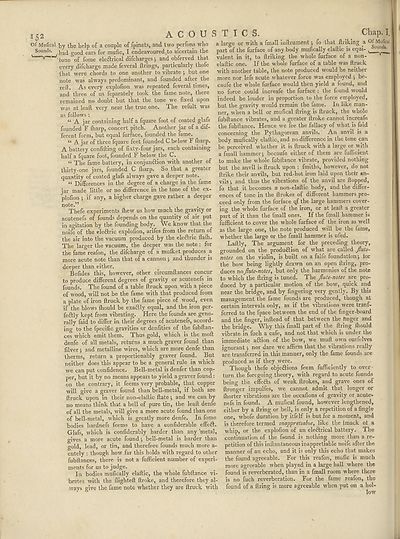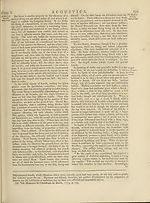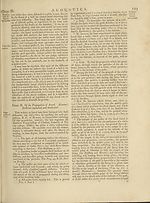Encyclopaedia Britannica, or, a Dictionary of arts, sciences, and miscellaneous literature : enlarged and improved. Illustrated with nearly six hundred engravings > Volume 1, A-AME
(170) Page 152
Download files
Complete book:
Individual page:
Thumbnail gallery: Grid view | List view

i^2 A C O U S
Of Mufical the help of a couple of fpinets, and two perfons who
Sounds. jia(j g00Cj ears for 1Tluf1C} I endeavoured . to afcertain the
i tone of feme eleftrical difeharges; and obferved that
every difeharge made feveral firings, particularly thofe
that were chords to one another to vibrate j but one
note was always predominant, and founded after the
reft. As every explofion was repeated feveral times,
and three of us feparately took the fame note, there
remained no doubt but that the tone we fixed upon
Avas at leaf! very near the true one. The refult Avas
as follows :
“ A jar containing half a fquare foot of coated glafs
founded F {harp, concert pitch. Another jar of a dif¬
ferent form, but equal furface, founded the fame.
“ A jar of three fquare feet founded C below F fharp.
A battery confiding of fixty-four jars, each containing
half a fquare foot, founded F below the C.
“ The fame battery, in conjunction Avith another of
thirty-one jars, founded C (harp, bo that a greater
quantity of coated glafs always gave a deeper note.
“ Differences in the degree of a charge in the fame
jar made little or no difference in the tone of the ex¬
plofion ; if any, a higher charge gave rather a deeper
note.”
Thefe experiments {hew us how much the gravity or
acutenefs of founds depends on the quantity of air put
in agitation by the founding body. We knoAV that the
noife of the ele&ric explofion, arifes from the return of
the air into the vacuum produced by the eleftric flafh.
The larger the vacuum, the deeper Avas the note : for
the fame reafon, the difeharge of a mufket produces a
more acute note than that of a cannon 5 and thunder is
deeper than either.
Befides this, however, other circumftances concur
to produce different degrees of gravity or acutenefs in
founds. The found of a table ftmek upon with a piece
of wood, Avill not be the fame Avith that produced from
a plate of iron ftruck by the fame piece of Avood, even
if the bloAVs fhould be exa&ly equal, and the iron per-
feftly kept from vibrating. Here the founds are gene¬
rally faid to differ in their degrees of acutenefs, accord¬
ing to the fpecific gravities or denfities of the fubftan-
ces which emit them. Thus gold, which is the mofl
denfe of all metals, returns a much graver found than
filver •, and metalline wires, which are more denfe than
therms, return a proportionably graver found. But
neither does this appear to be a general rule in which
Ave can put confidence. Bell-metal is denfer than cop¬
per, but it by no means appears to yield a graver found:
on the contrary, it feems very probable, that copper
Avill give a graver found than bell-metal, if both are
ftruck upon in their non-elaftic ftate j and Ave can by
no means think that a bell of pure tin, the leaft denfe
of all the metals, Avill give a more acute found than one
of bell-metal, Avhich is greatly more denfe. In fome
bodies hardnefs feems to have a eonfiderable effefl:.
Glafs, Avhich is confiderably harder than any ’metal,
gives a more acute found •, bell-metal is harder than
gold, lead, or tin, and therefore founds much more a-
cutely : though hoAV far this holds Avith regard to other
fubftances, there is not a fufficient number of experi¬
ments for us to judge.
In bodies mufically elaftic, the whole fubftance vi¬
brates Avith the flighteft ftroke, and therefore they al¬
ways give the fame note Avhether they are ftruck Avith
TICS. Chap. I.
a large or Avith a fmall inftrument j fo that linking a Of Mulka!
part of the furface of any body mufically elaftic is equi¬
valent in it, to ftriking the Avhole furface of a non-
elaftic one. If the whole furface of a table was ftruck
Avith another table, the note produced Avould be neither
more nor lefs acute Avhatever force was employed ; be-
caufe the Avhole furface would then yield a found, and
no force could increafe the furface : the found Avould
indeed be louder in proportion to the force employed,
but the gravity would remain the fame. In like man¬
ner, Avhen a bell or mufical firing is ftruck, the Avhole
fubftance vibrates, and a greater ftroke cannot increafe
the fubftance. Hence we fee the fallacy of what is faid
concerning the Pythagorean anvils. An anvil is a
body mufically elaftic, and no difference in the tone can
be perceived Avhether it is ftruck with a large or vyitli
a fmall hammer j becaufe either of them are fufficient
to make the whole fubftance vibrate, provided nothing
but the anvil is ftruck upon : fmiths, hoAvever, do not
ftrike their anvils, but red-hot iron laid upon their an¬
vils *, and thus the vibrations of the anvil are flopped,
fo that it becomes a non-elaftic body, and the differ¬
ences of tone in the ftrokes of different hammers pro¬
ceed only from the furface o%f the large hammers cover¬
ing the Avhole furface of the iron, or at leaft a greater
part of it than the fmall ones. If the fmall hammer is
fufficient to cover the whole furface of the iron as Avell
as the large one, the note produced will be the fame,
whether the large or the fmall hammer is ufed.
Laftly, The argument for the preceding theory,
grounded on the produftion of Avhat are called flute-
notes on the violin, is built on a falfe foundation j tor
the boAV being lightly draAvn on an open ftring, pro¬
duces no flute-notes, but only the harmonies of the note
to Avhich the ftring is tuned. The flute-notes are pro¬
duced by a particular motion of the boAV, quick and
near the bridge, and by fingering very gently. By this
management the fame founds are produced, though at
certain intervals only, as if the vibrations Avere tranf-
ferred to the fpace between the end of the finger-board
and the finger, inftead of that betAveen the finger and
the bridge. Why this fmall part of the ftring ffiould
vibrate in fuch a cafe, and not that which is under the
immediate aflion of the boAV, we muft oAvn ourfelves
ignorant j nor dare Ave affirm that the vibrations really
are transferred in this manner, only the fame founds are
produced as if they Avere.
Though thefe objections feem fufficiently to over¬
turn the foregoing theory, Avith regard to acute founds
being the efteCts of weak ftrokes, and grave ones of
ftronger impulfes, Ave cannot admit that longer or
ffiorter vibrations are the occafions of gravity or acute¬
nefs in found. A mufical found, however lengthened,
either by a ftring or bell, is only a repetition of a Angle
one, whofe duration by itfelf is but for a moment, and
is therefore termed inappretiabie, like the imack of a
whip, or the explofion of an eleftrical battery. The
continuation of the found is nothing more than a re¬
petition of this inftantaneous inappretiabie noife after the
manner of an echo, and it is only this echo that makes
the found agreeable. For this reafon, mufic is much
more agreeable Avhen played in a large hall where the
found is reverberated, than in a fmall room where there
is no fuch reverberation. For the fame reafon, the
found of a ftring is more agreeable Avhen put on a hol-
Ioav
Sounds.
Of Mufical the help of a couple of fpinets, and two perfons who
Sounds. jia(j g00Cj ears for 1Tluf1C} I endeavoured . to afcertain the
i tone of feme eleftrical difeharges; and obferved that
every difeharge made feveral firings, particularly thofe
that were chords to one another to vibrate j but one
note was always predominant, and founded after the
reft. As every explofion was repeated feveral times,
and three of us feparately took the fame note, there
remained no doubt but that the tone we fixed upon
Avas at leaf! very near the true one. The refult Avas
as follows :
“ A jar containing half a fquare foot of coated glafs
founded F {harp, concert pitch. Another jar of a dif¬
ferent form, but equal furface, founded the fame.
“ A jar of three fquare feet founded C below F fharp.
A battery confiding of fixty-four jars, each containing
half a fquare foot, founded F below the C.
“ The fame battery, in conjunction Avith another of
thirty-one jars, founded C (harp, bo that a greater
quantity of coated glafs always gave a deeper note.
“ Differences in the degree of a charge in the fame
jar made little or no difference in the tone of the ex¬
plofion ; if any, a higher charge gave rather a deeper
note.”
Thefe experiments {hew us how much the gravity or
acutenefs of founds depends on the quantity of air put
in agitation by the founding body. We knoAV that the
noife of the ele&ric explofion, arifes from the return of
the air into the vacuum produced by the eleftric flafh.
The larger the vacuum, the deeper Avas the note : for
the fame reafon, the difeharge of a mufket produces a
more acute note than that of a cannon 5 and thunder is
deeper than either.
Befides this, however, other circumftances concur
to produce different degrees of gravity or acutenefs in
founds. The found of a table ftmek upon with a piece
of wood, Avill not be the fame Avith that produced from
a plate of iron ftruck by the fame piece of Avood, even
if the bloAVs fhould be exa&ly equal, and the iron per-
feftly kept from vibrating. Here the founds are gene¬
rally faid to differ in their degrees of acutenefs, accord¬
ing to the fpecific gravities or denfities of the fubftan-
ces which emit them. Thus gold, which is the mofl
denfe of all metals, returns a much graver found than
filver •, and metalline wires, which are more denfe than
therms, return a proportionably graver found. But
neither does this appear to be a general rule in which
Ave can put confidence. Bell-metal is denfer than cop¬
per, but it by no means appears to yield a graver found:
on the contrary, it feems very probable, that copper
Avill give a graver found than bell-metal, if both are
ftruck upon in their non-elaftic ftate j and Ave can by
no means think that a bell of pure tin, the leaft denfe
of all the metals, Avill give a more acute found than one
of bell-metal, Avhich is greatly more denfe. In fome
bodies hardnefs feems to have a eonfiderable effefl:.
Glafs, Avhich is confiderably harder than any ’metal,
gives a more acute found •, bell-metal is harder than
gold, lead, or tin, and therefore founds much more a-
cutely : though hoAV far this holds Avith regard to other
fubftances, there is not a fufficient number of experi¬
ments for us to judge.
In bodies mufically elaftic, the whole fubftance vi¬
brates Avith the flighteft ftroke, and therefore they al¬
ways give the fame note Avhether they are ftruck Avith
TICS. Chap. I.
a large or Avith a fmall inftrument j fo that linking a Of Mulka!
part of the furface of any body mufically elaftic is equi¬
valent in it, to ftriking the Avhole furface of a non-
elaftic one. If the whole furface of a table was ftruck
Avith another table, the note produced Avould be neither
more nor lefs acute Avhatever force was employed ; be-
caufe the Avhole furface would then yield a found, and
no force could increafe the furface : the found Avould
indeed be louder in proportion to the force employed,
but the gravity would remain the fame. In like man¬
ner, Avhen a bell or mufical firing is ftruck, the Avhole
fubftance vibrates, and a greater ftroke cannot increafe
the fubftance. Hence we fee the fallacy of what is faid
concerning the Pythagorean anvils. An anvil is a
body mufically elaftic, and no difference in the tone can
be perceived Avhether it is ftruck with a large or vyitli
a fmall hammer j becaufe either of them are fufficient
to make the whole fubftance vibrate, provided nothing
but the anvil is ftruck upon : fmiths, hoAvever, do not
ftrike their anvils, but red-hot iron laid upon their an¬
vils *, and thus the vibrations of the anvil are flopped,
fo that it becomes a non-elaftic body, and the differ¬
ences of tone in the ftrokes of different hammers pro¬
ceed only from the furface o%f the large hammers cover¬
ing the Avhole furface of the iron, or at leaft a greater
part of it than the fmall ones. If the fmall hammer is
fufficient to cover the whole furface of the iron as Avell
as the large one, the note produced will be the fame,
whether the large or the fmall hammer is ufed.
Laftly, The argument for the preceding theory,
grounded on the produftion of Avhat are called flute-
notes on the violin, is built on a falfe foundation j tor
the boAV being lightly draAvn on an open ftring, pro¬
duces no flute-notes, but only the harmonies of the note
to Avhich the ftring is tuned. The flute-notes are pro¬
duced by a particular motion of the boAV, quick and
near the bridge, and by fingering very gently. By this
management the fame founds are produced, though at
certain intervals only, as if the vibrations Avere tranf-
ferred to the fpace between the end of the finger-board
and the finger, inftead of that betAveen the finger and
the bridge. Why this fmall part of the ftring ffiould
vibrate in fuch a cafe, and not that which is under the
immediate aflion of the boAV, we muft oAvn ourfelves
ignorant j nor dare Ave affirm that the vibrations really
are transferred in this manner, only the fame founds are
produced as if they Avere.
Though thefe objections feem fufficiently to over¬
turn the foregoing theory, Avith regard to acute founds
being the efteCts of weak ftrokes, and grave ones of
ftronger impulfes, Ave cannot admit that longer or
ffiorter vibrations are the occafions of gravity or acute¬
nefs in found. A mufical found, however lengthened,
either by a ftring or bell, is only a repetition of a Angle
one, whofe duration by itfelf is but for a moment, and
is therefore termed inappretiabie, like the imack of a
whip, or the explofion of an eleftrical battery. The
continuation of the found is nothing more than a re¬
petition of this inftantaneous inappretiabie noife after the
manner of an echo, and it is only this echo that makes
the found agreeable. For this reafon, mufic is much
more agreeable Avhen played in a large hall where the
found is reverberated, than in a fmall room where there
is no fuch reverberation. For the fame reafon, the
found of a ftring is more agreeable Avhen put on a hol-
Ioav
Sounds.
Set display mode to:
![]() Universal Viewer |
Universal Viewer | ![]() Mirador |
Large image | Transcription
Mirador |
Large image | Transcription
Images and transcriptions on this page, including medium image downloads, may be used under the Creative Commons Attribution 4.0 International Licence unless otherwise stated. ![]()
| Permanent URL | https://digital.nls.uk/193134195 |
|---|
| Attribution and copyright: |
|
|---|
| Description | Ten editions of 'Encyclopaedia Britannica', issued from 1768-1903, in 231 volumes. Originally issued in 100 weekly parts (3 volumes) between 1768 and 1771 by publishers: Colin Macfarquhar and Andrew Bell (Edinburgh); editor: William Smellie: engraver: Andrew Bell. Expanded editions in the 19th century featured more volumes and contributions from leading experts in their fields. Managed and published in Edinburgh up to the 9th edition (25 volumes, from 1875-1889); the 10th edition (1902-1903) re-issued the 9th edition, with 11 supplementary volumes. |
|---|---|
| Additional NLS resources: |
|

